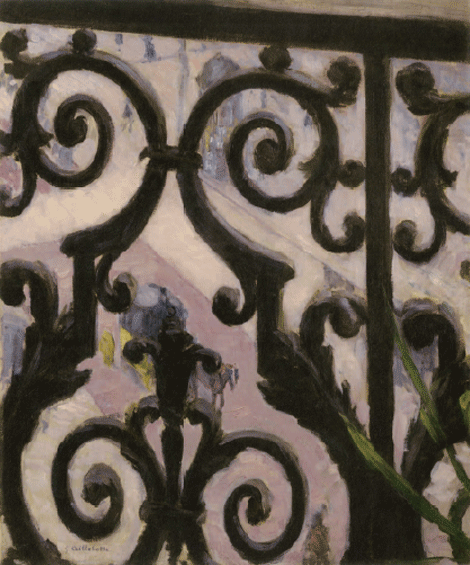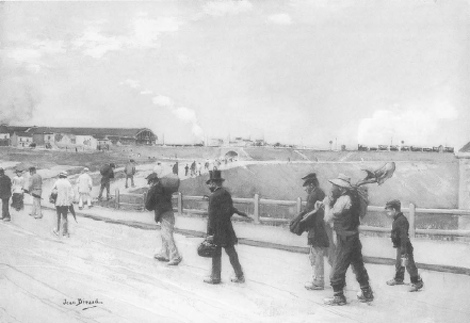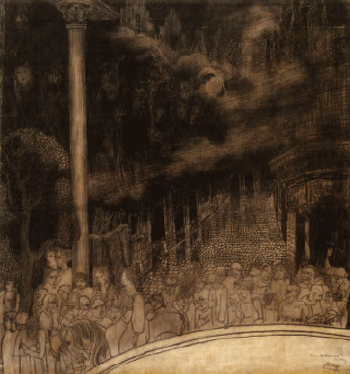Van Gogh Museum Journal 2003
(2003)– [tijdschrift] Van Gogh Museum Journal–
[pagina 120]
| |
[Documentation]
Gustave Caillebotte
View from a balcony, Paris 1880 | |
[pagina 121]
| |
Catalogue of acquisitions: paintings and drawings
| |
PaintingsCaillebotte, Gustave
| |
[pagina 122]
| |
in the background of the above-mentioned Floor-scrapers. Although as far as its subject matter is concerned View from a balcony is representative of the artist's oeuvre, it is at the same time an experiment pushed to the extreme. It clearly reflects the influence of Japanese prints, with their curious compositions and daring croppings of the picture's edge, which deeply influenced impressionist artists. Without any apology, the cast-iron balustrade has become the subject of the composition, creating a picture that takes us by surprise and seems to represent a conscious - and successful - attempt at a truly modern composition. With his direct approach, Caillebotte seeks above all to intrigue rather than simply please. In this way his painting makes a remarkably idiosyncratic impact. Several prominent authors have recognised the importance of this work. In his standard work on Caillebotte, the late Kirk Varnedoe expressed himself in lyrical terms when speaking of the canvas: ‘The picture is not only one of the most original conceptions in Caillebotte's art; it is also a pivot point in the history of painting, standing within one tradition while announcing another. [...] The image embodies not only a striking graphic beauty - a design before whose exuberance the name of Matisse springs irresistibly to mind - but also an extraordinary creative leap of the visual imagination.’Ga naar voetnoot3 The authoritative scholar of impressionism, Richard Brettell, pronounced: ‘This boldly painted and brilliantly composed work is one of the most original cityscapes of Paris by any Impressionist painter.’Ga naar voetnoot4 Caillebotte was a wealthy man and did not have to earn his living from his art. This is presumably why he sold little of his work during his lifetime and rarely exhibited. It is thought that View from a balcony was displayed at the fifth impressionist exhibition in 1880, but there is no absolute certainty about this.Ga naar voetnoot5 The artist died at an early age and his paintings remained largely in the family. Unlike other impressionist artists, Caillebotte more or less sank into oblivion. Not until the second half of the twentieth century would his work gradually appear on the art market and his fame spread. The Caillebotte family sold View from a balcony to Wildenstein in 1968 and it remained with this owner until it was bought by the Van Gogh Museum in 2003.
Sjraar van Heugten Provenance 1880-1968 family of the artist; 1968-2003 Wildenstein, New York; acquired by the Van Gogh Museum (2003)
Literature Exhib cat. Catalogue de la 5e expostion de peinture. Paris (10, rue des Pyramides) 1880, no. 12; exhib cat Gustave Caillebotte, Paris (Wildenstein) 1951, no. 34 (ill ), M Berhaut, Gustave Caillebotte, Paris 1951, no 99, G Bazin, ‘Gustave Caillebotte,’ in: Kindlers Malerie Lexikon, Zürich 1964, vol 1, p 590; exhib cat Caillebotte et ses amis impressionistes, Chartres (Musée Chartes) 1965, p 8, no 12; exhib cat Gustave Caillebotte, London (Wildenstein) 1966, p 25, no 22; exhib cat Gustave Caillebotte, New York (Wildenstein) 1968, no 32; M Berhaut, Caillebotte the impressionist, Lausanne 1968, p. 35, fig 16, R. Huyghe, L'impressionisme, Paris 1971, pp 244-45 (ill p 244), J.T K Varnedoe and T.P. Lee, exhib. cat. Gustave Caillebotte: a retrospective exhibition, Houston (The Houston Museum of Fine Arts) & New York (Brooklyn Museum) 1976-77, pp 38, 53, 57, 155 (ill ), 155-58, no. 55, M. Berhaut, ‘Gustave Caillebotte et le réalisme impressioniste,’ L'Oeil 268 (November 1977), p 48 (ill.), M. Berhaut, Caillebotte, sa vie et son oeuvre, Paris 1978, pp 46 (ill.), 47, 129 (ill ), no 138, p 249; exhib. cat. The crisis of impressionism, 1878-1882, Ann Arbor (The University of Michigan Museum) 1979-80, p. 72, no. 8, 73 (ill.), J.-F. Chevrier, ‘Modernisme et beauté industrielle,’ Photographies 5 (July 1984), p. 28 (ill.); J.K T Varnedoe, Gustave Caillebotte, New Haven & London 1987, pp. 152-54, no. 45 (ill.), E. Darragon, Caillebotte, Paris 1994, p 95, 96-97 (ill ), A. Distel et al., exhib. cat. Gustave Caillebotte 1848-1894, Paris (Galeries nationales du Grand Palais) 1994-95, pp 23, 182, 200 (ill ), 357, no. 66, A Distel et al., exhib. cat Gustave Caillebotte. urban impressionist, Paris (Galeries nationales du Grand Palais), Chicago (The Art Institute) & Los Angeles (County Museum of Art) 1994-95, pp 21, 144, 166 (ill.), 315, no 66, M. Berhaut and S. Pietri, Gustave Caillebotte: catalogue raisonné des peintures et pastels, Paris 1994, p VI (ill ), IX, 35, 131, no 147; J. Coignard, ‘Caillebotte; le blues des grands boulevards,’ Beaux-Arts 126 (September 1994), p. 67 (ill.); R. Shone, ‘Exhibitions reviews: Chicago and Paris, Gustave Caillebotte,’ Burlington Magazine 87 (March 1995), p 89 (ill.), 209; S. Johnston, exhib cat Faces of impressionism: portraits from American collections, Baltimore (The Baltimore Museum of Art) 1999-2000, p. 46 (note 4), fig. 4a, A. Callen, The art of impressionism: painting technique and the making of modernity, New Haven & London 2000, p 24, 25 (ill.); R.R. Bretell et al., exhib. cat Impressionism: painting quickly in France, London (National Gallery) & Amsterdam (Van Gogh Museum), 2000-01, pp. 221-22, fig. 157; exhib. cat. Hitchcock et l'art: coïncidences fatales, Montréal (Musée des Beaux-Arts) 2000-01, pp 380, 383 (ill ), 478 | |
[pagina 123]
| |
 | |
Works on paperBéraud, Jean
| |
[pagina 124]
| |
 | |
Toorop, Johannes Theodorus
| |
[pagina 125]
| |
]’); among them are one resembling a Madonna and a Japanese woman, presumably derived from a Japanese woodcut. Toorop and Verwey became acquainted around 1890. In the years that followed the artist would repeatedly make reference to Verwey and his literary oeuvre in his work. Verwey, by contrast, only mentioned Toorop once, and then only in 1918, at the request of one of his editors. In addition to Verwey, Toorop was also inspired by the writings of Emile Verharen, Jules Laforgue, Frederik van Eeden, Walt Whitman and Charles Baudelaire. The literary works he turned to did not necessarily have anything to do with his ideas about art; they were more of a stimulus to his rich imagination. For the most part, Cor cordium is drawn in black chalk; Toorop used pencil only to highlight certain details on some of the heads of the figures in the procession. He apparently did not bother too much about the quality of the paper he used: there was already a horizontal crease in the sheet when he began the work. When Toorop had almost completed the drawing he decided the paper was not large enough and he folded it around a piece of cardboard. He continued the drawing on the left-hand side, occupying about two centimetres of the new surface. The drawing still has its original moulded frame. In terms of formal, technique and style, this drawing is a beautiful and characteristic example of Toorop's work of around 1890. This was the period in which Toorop abandoned his neo-impressionist style for symbolism, without, however, going to extremes. Other masterpieces of these years include his Garden of sorrows in the Rijksprentenkabinet in Amsterdam, and Les rôdeurs in the Kröller-Müller Museum in Otterlo. With the acquisition of Cor cordium, the Van Gogh Museum now owns a drawing by Toorop, in addition to a painting, seven prints and seven letters. The letters in question were written to Johanna van Gogh-Bonger and shed light on Toorop's role in spreading Van Gogh's fame at the turn of the last century. Toorop had seen some of Vincent's paintings in Brussels at exhibitions of Les XX, and in 1892, using paintings and drawings from Johanna's collection, he compiled the first sizeable exhibition of Van Gogh's work to be held in the Netherlands; it was shown in The Hague at the artists' society the Haagsche Kunstkring. In 1894-95 Cor cordium formed part of a portfolio produced by this same society. The portfolio, containing prints and drawing for sale, would travel the length and breadth of the Netherlands. Cor cordium, with an asking price of 450 guilders, was the most expensive work and remained unsold until 1899, when it was acquired by no less a figure than the poet Albert Verwey. Before 1899 the drawing appeared for sale at various exhibitions. One such show was that held in Utrecht in 1898-99 at the Vereeniging ‘Voor de Kunst,’ which had on display works by Toorop together with drawings by Van Gogh from Johanna van Gogh-Bonger's collection. The critics were enthusiastic about the combination of these two artists. One spoke in a review of ‘[...] two isolated individuals [...], as one in thought and feeling; so utterly different in their manner of expressing those thoughts and feelings, but both equally powerful, equally lofty and [...] equally beautiful.’ The drawing Cor cordium has been on loan to the museum for several years and now with its acquisition it joins the work of Van Gogh for good.
Marije Vellekoop
Provenance Albert Verwey, Noordwijk aan Zee, 1899-1936, Mrs Dr M Nijland-Verwey, Santpoort, 1936, heirs of Mrs Dr M. Nijland-Verwey, private collection, Utrecht (on loan to the Van Gogh Museum, 1996-2003), acquired by the Van Gogh Museum (2003)
Literature A Plasschaert, Jan Toorop, Amsterdam 1925, p 34, 1890, no 8, Bettina Polak, Het fin-de siècle in de Nederlandse schilderkunst de symbolistische beweging 1890-1900, The Hague 1955, pp 97-98, no 16, fig 8, Mea Nijland-Verwey, Kunstenaarslevens: de briefwisseling van Albert Verwey met Alphons Diepenbrock, Herman Gorter, R N Roland Holst, Henriétte van der Schalk en J Th Toorop, Assen 1959, fig opp p 65, R Siebelhoff, The early development of Jan Toorop 1879-1892 (diss, University of Toronto, 1973), pp 134, 281-82, R de Leeuw, exhib cat Haagse Kunstkring: werk verzameld, The Hague (Gemeentemuseum) 1977, p 15, fig 20, C Blotkamp and M Rijnders, exhib cat Kunstenaren der idee symbolistische tendenzen in Nederland, ca. 1880-1930, The Hague (Gemeentemuseum) 1978, pp. 80-81, fig 48, Rein van der Wiel, Ewijkshoeve, tuin van tachtig, Amsterdam 1988, Marja Bosma et al, exhib cat. Vier generaties een eeuw lang de kunstenaarsfamile Toorop/Fernhout, Utrecht (Centraal Museum) 2001, pp. 41-43, cat 14. |
|

